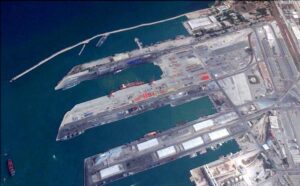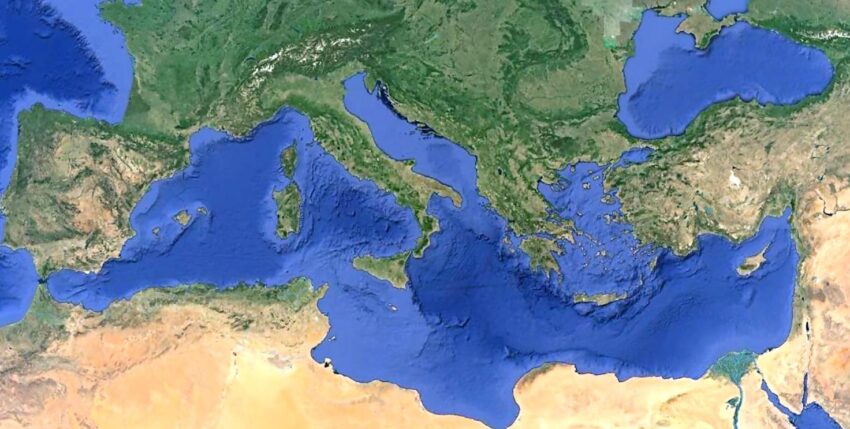Presence without "power projection"
The very term "Mediterranean region" indicates that maritime influences are also prevalent in North Africa and Southern Europe. Maritime trade has dominated since ancient times, and it was not only with the opening of the Suez Canal that the eastern Mediterranean became a centre for oriental trade. To this day, the region is considered a "strategic bridge" to the Middle East and beyond to South (Asia).
Bosphorus bottleneck
Russia's Tsar Peter I, who at the beginning of the 18th century Russian navy was also endeavouring to gain maritime influence in the south of his empire. Via the Black Sea, he sought access to the Mediterranean Seabut the Ottoman Empire, which dominated the region, put an end to his plans in the Sea of Azov. 50 years later, Tsarina Catherine II once again looked southwards, established her first Black Sea fleet, sent the Baltic Fleet The Ottomans moved to the Aegean and started two Russo-Turkish wars, which ended with the conquest of the Crimea (1783) and the retreat of the Ottomans from large parts of the Black Sea coast.
They even had to agree to an alliance with Russia that allowed the Black Sea Fleet to pass through the Turkish Straits and conduct operations in the Black Sea. Mediterranean Sea allowed. There, a group led by Admiral Ushakov Fleet Greek islands occupied by France, which founded the "Republic of the Seven Islands" in 1799 - the first "independent Greek state" since Byzantine times. Even today, the Black Sea Fleet takes part in annual commemorations in Greece. At the time, the Black Sea Fleet pursued the French as far as western Greece. Mediterranean Seablockaded Genoa and Ancona, attacked Naples and even Rome.
The Ottomans did not remain in the imposed alliance for long. In the middle of the 19th century, together with England and France, they began the First Crimean War, which brought Russia a heavy defeat. In the Treaty of Paris (1856), it had to renounce its Black Sea fleet, but was ready for a new war just two decades later, in which the Ottoman Empire (now again without allies) had no chance. The now victorious Russia was allowed to revive its Black Sea Fleet, but control of the Turkish straits remained in Ottoman hands.
During the First World War, the Russian navy not in the Mediterranean Seawas content to "lock out" the Ottomans from the Black Sea by, among other things, minelaying the Bosporus. It was not until 1920 that Russian warships passed through the Bosphorus again: they fled from the revolution to Bizerta (Tunisia), where they were interned and handed over to the new Soviet Union in 1924.
The Ottoman Empire had collapsed after the First World War, but this made little difference to the Soviet Union's maritime ambitions. The League of Nations placed the Turkish Straits under its control. The Treaty of Montreux (1936), which is still in force today, lays down strict rules (number, tonnage, registration deadlines) for the passage of warships in times of peace; in times of war, Turkey alone decides whether warships are allowed to sail through the straits.
Counterweight to the US 6th Fleet
During the Second World War, the Soviet Navy was largely limited to coastal defence and support of the land forces. A lack of core logistical capabilities limited operations in non-domestic waters, but the onset of the "Cold War" forced Moscow to ignore this shortcoming. After the Suez War (1956) with the involvement of British and French naval forces, but even more so after the US intervention in Lebanon (1958), Moscow moved warships into Mediterranean Sea. They were intended to underpin strategic interests, secure political influence and form a military counterweight to the US 6th Fleet. Until the mid-1960s, this was usually a mixed formation of units from the Northern Fleet and Baltic Fleet. Fleet.
The lack of logistical bases proved to be a central problem. Ideologically, allies were asked to use the harbour and were successful as early as 1958. Albania granted base rights and even allowed a base for Soviet submarines. However, the agreement only lasted three years; when Moscow fell out with China, the navy had to leave Albania again.
Improvisation was now required. A constant presence was politically indispensable, but did not necessarily mean "operations". In Mediterranean Sea ships were usually anchored in international waters. Standard anchorages were set up in the Gulf of Hammamet (off Tunisia), east of Malta and west of Crete, and later also in the Great Sirte, the Alboran Sea and the Aegean, and in some cases even anchor buoys were deployed. After military relations were established with Syria and Egypt, the naval bases there could also be used from the mid-1960s onwards.
The concept envisaged standing up to the US 6th Fleet with a small number of units present - which in practice was reduced to shadowing their aircraft carriers. In the event of a crisis/conflict, additional units were to be brought in quickly from the Black Sea. The Montreux Treaty, once so welcomed by the Soviet Union, turned out to be a boomerang. The Soviet navy was also only allowed to sail the Turkish straits with a maximum of nine warships at any one time (totalling a maximum of 15,000 tonnes) - and only with at least eight days' advance notice for each individual ship.
The Middle East War (1967) was the trigger for the establishment of a permanent Mediterranean squadron led by the Black Sea Fleet - the later 5th Eskadra. The Black Sea Fleet temporarily reinforced the formation to 27 units, which, however, were content with a mere presence. They kept an eye on events but, despite loudly proclaiming their solidarity with Syria and Egypt, were scrupulous in their endeavours to keep away from combat. When war broke out, all Soviet warships left Egyptian and Syrian harbours and retreated to the international waters of the Mediterranean Sea back. However, Moscow then played a fundamental role in the subsequent ceasefire: its threat of military intervention ended the Six-Day War.
The combined problems of remoteness from home, lack of logistical capacity and the Treaty of Montreux could only be effectively countered with basing rights in Mediterranean ports. Only then was a permanent presence of units capable of real operational missions possible. In return for the (political) support of Egypt and Syria in the Six-Day War and subsequent generous help with rearmament by the Soviet Union, the 5th Eskadra received base rights in Egypt and Syria.

The Soviet Navy now rapidly expanded its Mediterranean presence. Its growing self-confidence was also reflected in its increasingly aggressive behaviour towards the US 6th Fleet. Soviet warships simulated attacks on US aircraft carriers and harassed US ships to the point of collision. At the outbreak of the Yom Kippur War (1973), further units from the Black Sea, but also from the Northern Fleet and the Baltic Fleet, were deployed. Fleet ins Mediterranean Sea relocated. The 5th Eskadra evacuated Soviet personnel from Egypt and Syria and was also "prepared" to intervene alongside its allies. Ultimately, however, the ships once again kept away from all combat operations at sea, as they had done in 1967.
Egypt's President Sadat had already distanced himself from the Soviet Union before the war; after the war he made the break. For the 5th Eskadra, the use of Egyptian harbours was over. The small, poorly equipped Syrian harbours were by no means a substitute. Fleet visits to Algeria, Libya and Yugoslavia were intended to pave the way for additional alternatives. Libya finally allowed the limited use of two harbours (Tobruk, Bardia), and Yugoslavia approved repairs at a shipyard in Tivat against payment. This and the continued use of the now traditional anchorages allowed the 5th Eskadra to grow to a total of 40 - 50 ships, including up to eight submarines, by the mid-1980s. A constant flow of auxiliary vessels through the Turkish straits was to provide additional logistical support.
Without a direct link to really powerful landing facilities, however, the 5th Eskadra had hardly any operational flexibility and remained far removed from an officially declared instrument of effective "power projection". In its dealings with the US 6th Fleet, it confined itself to psychological muscle-flexing. During the US attacks on Libya (1985/86), it positioned its warships in the immediate vicinity of the US aircraft carriers and probably also provided the ally with situation information, but otherwise kept out of this conflict.
The same applied to the Mediterranean squadron as to the entire Soviet navy: although numerically strong in combat, it was not capable of long-term operations or even "expeditionary warfare" in non-domestic waters. Active intervention in regional conflicts was apparently never really on the agenda. The operational concept of the Black Sea Fleet's amphibious forces did include the conquest of the Turkish Straits in the event of war, but even this was only to ensure unhindered access to the bases and shipyards in the Black Sea.
From the Cold War to international cooperation

The collapse of the Soviet Union was a turning point. With the independence of the former Soviet republics, the Black Sea Fleet lost core elements of its operational and logistical base. Almost its entire shipyard infrastructure was now located in Ukraine, with which it also had to share its main base in Sevastopol. With a desolate financial situation, there was only one option: to withdraw to its own waters. Although the base in Tartus (Syria) was retained, a Black Sea Fleet workshop ship was still stationed there. Presence in the Mediterranean Sea was subordinated - and the 5th Eskadra was disbanded at the end of 1992.
After the end of the "Cold War", Russia now sought a compromise with the former enemy of the system. In 2001, the now re-established Russian navy The BlackSeaForce, which was activated once or twice a year for joint exercises under rotating command, was formed with the other Black Sea neighbours. Gradually, the Black Sea Fleet also returned to the Mediterranean Sea It returned to the Italian Navy, began annual bilateral exercises with the Italian Navy and even took an active part in the NATO anti-terrorism operation "Active Endeavour". The military doctrine issued in 2010 also included international cooperation and active participation in the fight against piracy/terrorism and in UN peacekeeping missions among the main tasks of the armed forces. In 2013/14, the Russian navy in the Mediterranean Sea essential functions in the removal of Syrian chemical weapons.
Travelling abroad was based on the premise of only going where it was "strategically justified and financially feasible" - but this applied above all to the Mediterranean Sea. In 2007, the then naval commander Admiral Masorin even called for a "routine naval presence" there again. Units of the Black Sea Fleet carried out harbour visits in France, Italy and Greece, and also called at North African ports and the Spanish enclave of Ceuta (resupply). Aircraft carrier ADMIRAL KUZNETSOV and cruiser PETR VELIKIY also moved from the Northern Fleet area to the Black Sea. Mediterranean Sea. In most cases, the Russian navy but with mere presence. A few exercises remained at a very low operational level; there was no question of the officially proclaimed "power projection".
With growing self-confidence, politicians formulated a directive for a significantly expanded global naval presence: "protection of maritime transport routes" (energy resources) was "of vital national interest". In 2013, Navy Chief Admiral Chirkov finally spoke of several "flotillas" that would be almost permanently present in non-domestic waters. The pioneer was the Mediterranean Sea. In the same year, a new Mediterranean squadron was formally established - de facto a revitalisation of the 5th Eskadra.
Since then, up to ten combat/aid ships have been deployed at any time in the eastern Mediterranean Sea present. Not only the Black Sea Fleet, but above all the Baltic Fleet Fleet and North Fleet contribute forces. The Russian navy presents this publicly as a capability for global operations across fleets. In reality, however, the units available in the Black Sea are not sufficient for such a high permanent presence. Not least with a view to the new organisation, the Black Sea Fleet is to be significantly strengthened in the coming years, with the addition of new frigates, corvettes and submarines taking top priority.
The logistical component remains an unresolved problem. The only permanent base is still in Tartus, in Syria, which is torn apart by civil war. Russia is also showing concern for its partner, ignoring an arms embargo imposed by the USA and the EU. In the very real realisation that Russian warships, unlike civilian freighters, remain unmolested, Russian landing ships transport military goods to Syria on almost weekly routine trips. According to the latest information, the Russian air force is even setting up its own forward operating base south of Latakia.
In peacetime, the Russian navy also supply other Mediterranean ports. Limassol (Cyprus), Valetta (Malta) and the Spanish enclave of Ceuta are already used almost routinely for resupply and maintenance through to minor repairs. However, attempts to have secure bases in the event of a conflict have so far been unsuccessful. Cyprus, Egypt, Libya and Montenegro have nothing against the occasional arrival of Russian warships, but granting them binding base rights is out of the question.
In the conflict with Ukraine (annexation of Crimea), Russia has manoeuvred itself onto the sidelines in terms of security policy. The international cooperation that has been painstakingly built up over 15 years is history again for the time being; memories of the Cold War are coming back to life. There are no longer any joint exercises with Western navies; reciprocal visits that were thought to be routine have been cancelled. Greece is the only country with which the historical relationship established more than 200 years ago with Admiral Ushakov is still maintained, and units of the Black Sea Fleet are sent to commemorative events every year.
Russian warship construction, which relies on Ukrainian and Western supplies (and is already struggling), is in serious trouble. In October 2014, Finance Minister Siluanov bluntly stated that Russia could not afford its medium-term (2016-25) armaments plan under Western sanctions and the drop in oil prices. Replacing import shortfalls with own products will take years. The defence plan, not least with a view to the Mediterranean Sea The planned strengthening of the Black Sea Fleet is likely to take longer than expected, and in the coming years the new Mediterranean Escadra will not be built without substantial support from the Northern Fleet and Baltic Fleet. Fleet get by.
Meanwhile, new allies are being sought to organise strategic interests in the Mediterranean region. In May of this year, the eastern Mediterranean Sea an exercise with a Chinese naval task force (disbanded anti-piracy unit) that was accompanied by a lot of propaganda but was not very demanding in terms of content. Egypt is also being courted. In June, the flagship of the Black Sea Fleet, the FK cruiser MOSKVA, visited Alexandria and also briefly practised with the Egyptian navy in a so-called "Passex". At the beginning of August, Russia finally presented the Egyptian Navy with an FK corvette of the TARANTUL class as a gift.
Whether the future will lead to a new Cold War or whether Russia and the West will come closer together again (once the Ukraine crisis has been resolved) cannot be predicted at present. Regardless of this, Russia will continue to endeavour to underline its strategic interests in the Mediterranean region by deploying its navy. However, the operational capabilities of the Mediterranean Escadra will remain limited. Without real power projection capabilities, the Russian navy must continue to be content with mere presence.
Author: Klaus Mommsen










